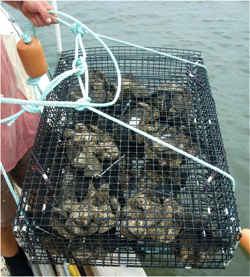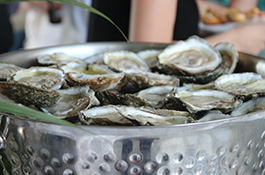Oyster aquaculture partnership offers new funding for watermen
When you think of the Chesapeake Bay, an iceberg probably isn’t the first thing that comes to mind. Yet it’s probably the most accurate picture of ongoing conservation activities to improve the health and vitality of the world’s third largest estuary. There’s a lot more going on below the surface than meets the eye.
One such conservation activity is a new collaborative program to restore about 40 acres of privately leased oyster beds. The newest chapter in a now 8-year partnership among USDA’s Natural Resources Conservation Service (NRCS), the Virginia Marine Resources Commission (VMRC), and the Virginia Institute of Marine Science (VIMS), the program seeks to improve Bay water quality through targeted funding and resources to create habitat for oysters, fish, and other wildlife.
Through the program, oyster growers who receive services from the Accomac, Chesapeake, Gloucester, Quinton, Smithfield, Tappahannock, and Warsaw NRCS service centers may be eligible for $180,000 in funding to deploy new shells and begin spat-on-shell production in target areas. Interested individuals must submit a signed VMRC pre-approval form and a completed NRCS application by May 15, 2020 to be considered for FY 2020 funding.
 “Oyster aquaculture is a rapidly growing industry in Virginia,” says NRCS State Conservationist Jack Bricker. “This partnership to reestablish reefs on private shellfish grounds offers a win for watermen and the Bay as the growing populations remove large volumes of nutrients from these waters.”
“Oyster aquaculture is a rapidly growing industry in Virginia,” says NRCS State Conservationist Jack Bricker. “This partnership to reestablish reefs on private shellfish grounds offers a win for watermen and the Bay as the growing populations remove large volumes of nutrients from these waters.”
“Overharvest is often the first contributing factor that comes to mind when people think about the decline of the Chesapeake Bay Oyster,” adds Andrew Button, VMRC Department Head, Conservation and Replenishment.
“However, habitat loss and oyster diseases played an equal, if not larger, role in the decline. This project tackles both of these issues by encouraging the creation of new oyster habitat, and by utilizing oysters that have been selectively bred in hatcheries at VIMS for increased resistance to common oyster diseases.”
 NRCS helped fund this project through USDA’s Regional Conservation Partnership Program (RCPP). Created in the 2014 Farm Bill, RCPP draws on local knowledge and networks to fuel collaborative projects and empowers communities to design conservation solutions that work best for their regions.
NRCS helped fund this project through USDA’s Regional Conservation Partnership Program (RCPP). Created in the 2014 Farm Bill, RCPP draws on local knowledge and networks to fuel collaborative projects and empowers communities to design conservation solutions that work best for their regions.
For more information on Virginia RCPP projects, visit www.va.nrcs.usda.gov. To learn more about VMRC projects and activities, visit www.mrc.virginia.gov/Shellfish_Aquaculture.shtm.

